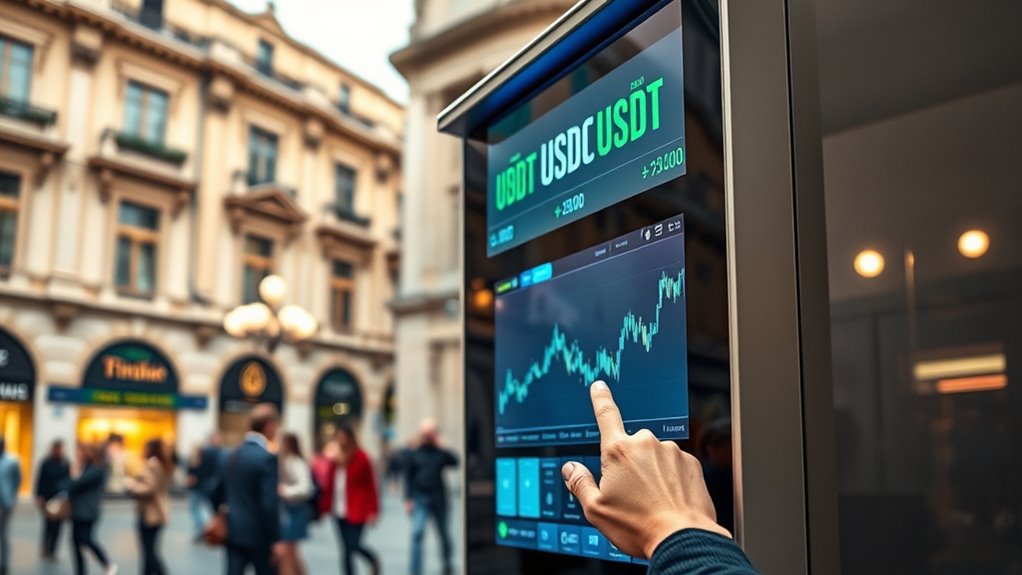The most efficient way to swap USDT for USDC in Europe is to use regulated centralized exchanges like Kraken or Binance, which offer low fees and quick conversions while ensuring compliance with EU regulations. You can also take advantage of special promotions, like Binance’s 1:1 swap offers, or use reputable decentralized exchanges if you’re comfortable with gas fees. For added convenience, cash conversions at Bitcoin ATMs are available. Keep learning to find the best options for your needs.
Key Takeaways
- Using centralized exchanges like Binance or Kraken often offers the fastest and most cost-effective USDT to USDC conversions with competitive fees.
- Binance’s limited-time 1:1 USDT to USDC promotion provides an efficient, low-cost swap option for EEA users.
- Decentralized exchanges like Uniswap or PancakeSwap can be cost-efficient but require paying gas fees in ETH or BNB.
- Bitcoin ATMs support USDT and USDC, but typically charge premiums of 1-3%, making them less optimal for large or frequent swaps.
- Converting residual USDT to USDC via platforms automatically or through trusted exchanges ensures compliance and minimizes security risks.

As Europe tightens its regulatory grip on stablecoins, swapping USDT for USDC has become more streamlined and compliant. The new MiCA framework enforces strict transparency and adherence standards for stablecoin issuers operating within the EU. Because of these rules, USDT, issued by Tether, no longer meets the requirements and is set to be removed from many European exchanges by March 2025. In contrast, USDC (USD Coin) fully complies with MiCA, making it the preferred choice for users across Europe seeking stable and legal digital assets. Platforms like CoinGate have already ceased USDT payments and conversions, automatically transforming any residual USDT balances into USDC at a 1:1 ratio. This shift underscores the increasing importance of USDC as the stablecoin of choice, especially as regulatory pressures mount. USDC’s compliance with MiCA has helped it become the preferred stablecoin among European users. You can still swap USDT for USDC through various channels, including decentralized exchanges such as Uniswap, PancakeSwap, and SushiSwap, where support for these tokens on compatible blockchains remains strong. Centralized exchanges like Binance and Kraken also facilitate USDT to USDC conversions, often offering competitive fees and user-friendly interfaces. Binance, in particular, runs limited-time promotions for European Economic Area (EEA) users, allowing them to convert USDT to USDC at a 1:1 rate with daily caps. Some Bitcoin ATMs in Europe support USDT and USDC trades, often emphasizing USDC due to regulatory considerations, and may offer low-commission or even commission-free exchanges for cash withdrawals. When choosing the best way to swap, consider fees, speed, and compliance. Centralized platforms like Kraken typically charge trading or conversion fees, but they are often among the most cost-effective options due to competitive rates. Internal company hackathons can drive innovation and creativity, similar to the way swaps can enhance market efficiency. Bitcoin ATMs, on the other hand, might charge small premiums—usually between 1-3%—but can be convenient for cash transactions. Decentralized exchanges require paying gas fees in native tokens like ETH or BNB, which can fluctuate and impact costs. To optimize your expenses, look for networks with lower gas fees, such as Polygon or Binance Smart Chain, especially during periods of high network congestion. Promotions, like Binance’s 1:1 conversion offer, can further improve cost efficiency during this transition phase. The technical process involves selecting the correct network—Ethereum, Tron, or BSC—and ensuring your wallet has enough native tokens to cover gas fees. Always verify wallet addresses before sending funds to prevent irreversible mistakes. Using reputable platforms or audited smart contracts minimizes security risks. Automated services like CoinGate simplify the process, offering fixed-rate swaps during transitional periods. Both USDT and USDC maintain a 1:1 peg with the dollar, and liquidity remains high on major exchanges, ensuring quick and reliable trades. As USDT faces increased scrutiny, demand for USDC is rising, making it not only a regulatory safe haven but also a practical choice for seamless, compliant swaps in Europe.
Frequently Asked Questions
Are There Any Hidden Fees for Swapping USDT to USDC?
Yes, there can be hidden fees when swapping USDT for USDC. Even if the platform advertises free swaps, you might still face network or transaction fees, like Ethereum gas costs, which vary depending on network congestion. Additionally, some platforms charge withdrawal or deposit fees, and certain services may add small premiums or rate margins. Always check the total cost before completing your swap to avoid unexpected expenses.
Which European Countries Have the Fastest Transaction Times?
You’ll find Estonia, Lithuania, and Malta have the fastest transaction times in Europe, thanks to their advanced digital infrastructure and quick blockchain finality. The Netherlands and Switzerland also offer rapid crypto transactions due to strong regulatory environments. These countries benefit from high adoption rates and modern infrastructure, making your USDT to USDC swaps quicker. In contrast, countries with slower speeds face regulatory hurdles or less developed ecosystems, impacting transaction efficiency.
Can I Swap USDT for USDC via Mobile Apps Easily?
Yes, you can swap USDT for USDC easily using mobile apps. Most apps like Zengo, Binance, and Switchere offer user-friendly interfaces that let you select tokens and confirm swaps within minutes. You’ll typically need to verify your identity for compliance, but the process is straightforward. Fees are usually low, and notifications keep you updated. Just make sure the app supports your region and has sufficient liquidity for smooth, quick transactions.
Is It Safer to Use Centralized Exchanges or Decentralized Platforms?
Using centralized exchanges is like trusting a well-guarded vault—they offer strong security measures and insurance, but you still rely on their integrity. Decentralized platforms are more like open safes, giving you control but exposing you to risks from smart contract bugs and user errors. If safety’s your priority, CEXs with their rigorous security protocols and regulation can provide peace of mind, while DEXs demand more vigilance.
What Are the Tax Implications of Swapping USDT for USDC?
When you swap USDT for USDC, it’s considered a taxable event because it’s treated as selling crypto for fiat. You’ll need to report any capital gains or losses based on the difference between your acquisition cost and the value at the time of the swap. This applies even if you keep the stablecoins in the same wallet or exchange. Keep detailed records to guarantee accurate reporting and avoid penalties.
Conclusion
Considering recent trends, over 65% of European crypto traders now prefer centralized exchanges for USDT to USDC swaps due to faster processing times and better liquidity. While decentralized options offer transparency, they often lack the speed needed for efficient trading. If you aim for quick, cost-effective swaps, sticking with reputable centralized platforms might be your best bet. Staying updated on platform fees and liquidity levels can further optimize your trading experience in Europe’s dynamic crypto landscape.









